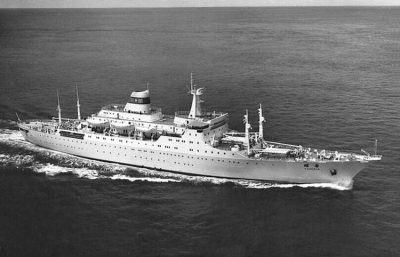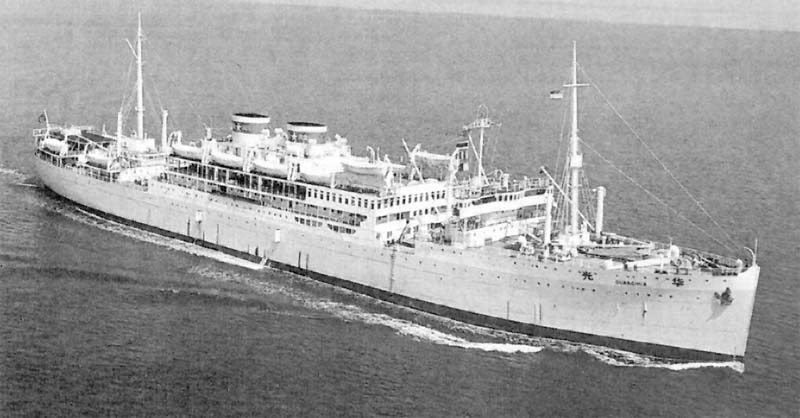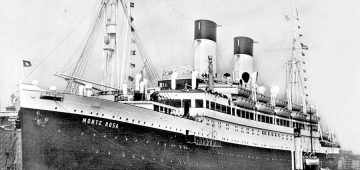During the early 1960s, the Chinese merchant marine comprised only thirty vessels, but by two decades later the situation was greatly changed. Lloyd’s Register of Shipping did not publish information on Chinese shipbuilders, and only on COSCO owned Chinese shipping, until just over twenty years ago, so little was known on this subject. The meteoric rise of Chinese shipbuilding and of COSCO, founded on 27th April 1961 as the China Ocean Shipping Company, and the subsequent merger in February 2016 with container carrier China Shipping Container Lines (CSCL formed in 1997) to form the largest shipping company in the world, have now placed China in the top echelon of maritime countries. China had eleven shipping companies and five hundred ships in 1985, including fifteen feeder container ships with twenty more on order. The main shipbuilding and repair yards were at Shanghai, Dalian, Tianjin, Guangzhou and Wuhan.

Several examples of a new type of engines aft container/passenger (CONPAX) have been completed over the last twenty years, with most for Chinese ownership. By 1998, much of the massive Chinese industrial production had relocated to the Yangtze River Delta (YRD) and the Pearl River Delta (PRD) during the two decades from 1978. There were over twenty large Chinese shipbuilding groups in operation and 45 shipyards after 1998, operating with significantly lower production costs over other countries including Japan and South Korea, as well as having a growing demand for Chinese shipping at home. China joined the World Trade Organisation (WTO) in December 2001 after fifteen years of negotiation, opening up many new markets for ships, as this lifted previous WTO restrictions on Chinese trade and industrial production. China now has 35% of global shipbuilding capacity with huge completion totals that reflect its pole position in world shipbuilding that it has enjoyed for both new ships and the order book for long series production of ships. China overtook South Korea as the leading shipbuilding nation in the world in the first half of 2010.

The Shanghai To Hong Kong Passenger Route
The former twin funnelled twin screw passenger ship Highland Princess entered service for the Chinese on the China to East Africa route in 1960 as Guanghua, and later on the route from Shanghai to Hong Kong under the modified name of Guang Hua. She had been built for Nelson Line in 1930 by Harland & Wolff Ltd. at Belfast and had transferred to Royal Mail Line two years later when taken over. After strenuous service as a troop ship, her accommodation was revamped to 100 First Class and 340 Third Class passengers. She was sold to John Latsis of Greece in 1959 and renamed Marianna, and then a year later to Czechfracht of Czechoslov-akia to become Slapy, before sailing to Shanghai by the end of 1960 as Guang Ha for service on the various routes until 1980. She had four decks with dimensions of length 544.6 feet, moulded beam of 69.2 feet and depth of 28.8 feet, fo’c’stle of length 155 feet, bridge deck of length 97 feet to give a measurement of 14,216 grt. She was designed to carry meat home from South America with an insulated space of 521,000 cubic feet and a service speed of sixteen knots from twin eight cylinder direct acting B & W oil engines. The navigating bridge was fitted with the latest radar, gyrocompass, direction finder, echo sounding and position fixing devices, and very high frequency radio telephone.

Guanghua was replaced on the China to East Africa route (Mombasa or Dar-es-Salaam) by a new French built passenger liner in 1967 named Yao Hua when launched at the St. Nazaire yard of Chantiers de l’Atlantique. She had accommodation for 488 passengers on four decks and dimensions of length 489.0 feet, moulded beam of 69.0 feet, depth of 44.0 feet and loaded draft of 21.8 feet giving a gross tonnage of 10,500. She had a single funnel placed just aft of ‘midships, a bipod navigation mast and a foremast and mainmast, with two holds forward of the superstructure and one hold aft. She was twin screw and powered by twin nine cylinder single acting Sulzer oil engines of 15,000 bhp manufactured by Compagnie Constructione Meccanica to give a service speed of 21.5 knots. Electricity was provided by four generators, and her bridge equipment had the latest and similar versions of equipment to the older Guanghua.

Subscribe today to read the full article!
Simply click below to subscribe and not only read the full article instantly, but gain unparalleled access to the specialist magazine for shipping enthusiasts.


Comments
Sorry, comments are closed for this item